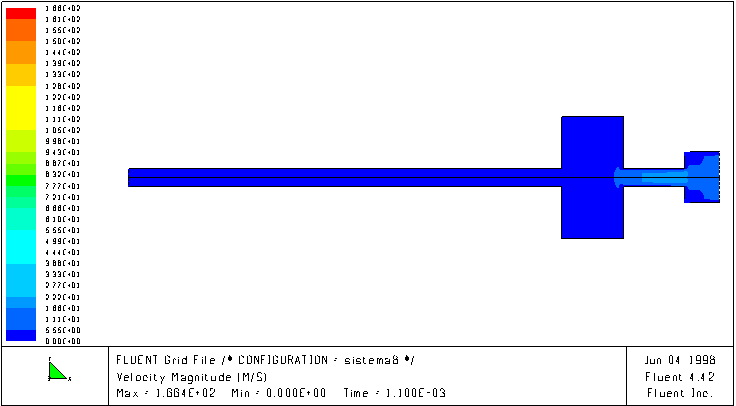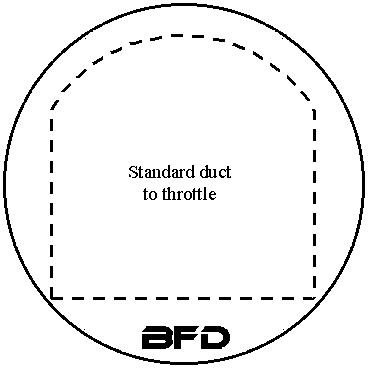 |
I made a custom intake out of 3.5 inch stormwater pipe - super smooth
inside and about 33% larger cross section. I replaced the convoluted connector hose with a
smooth rubber hose. Look at the size of it - so much bigger. The standard duct is squared off along the bottom to make more room for the resonant chamber (reduces noise). The BFD is the same diameter as the AFM and reduces down to the throttle body at that connection. The convoluted rubber connector between AFM and standard duct also needs to be replaced with a larger 3.5 inch smooth wall rubber pipe. I asked AutoSpeed editor Julian Edgar about the chamber "The devices are resonant chambers, forming part of the tuned intake system prior to the throttle butterfly. In addition to aiding volumetric efficiency (ie breathing) they are also sometimes used to reduce intake noise. If you are replacing the duct into which a resonant chamber is connected with a pipe size much larger than the original, we wouldn't bother reconnecting the chamber." Ok so time for testing |
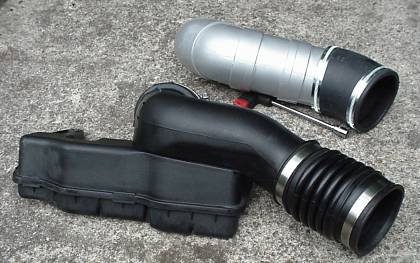 |
The black one down the bottom is the standard intake and resonant chamber. I filled the chamber with water and measured it at 1.2 litres. |
 |
The standard intake starts at 3.5 inch at the Air Flow Meter (AFM) and constricts to 3 inches after the convoluted pipe. The Custom intake was 3.5 inches all the way |
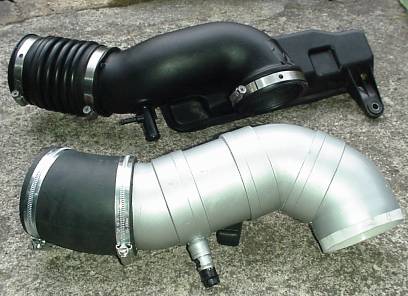 |
The other vacuum fitting fell off for this photo. The large fitting sticking out is for the idle control -all the air the engine needs when idling goes though this little hole. With the custom intake fitted you can see the engine better - the standard intake resonator obscures the intake side of the "V" engine |
 |
Here is the intake installed and time for a drive. First thing is how loud
it is. Under full throttle it hurts my ears! You can listen to it in the Exhaust Sounds
page. Timing it on my specific test road with a stop watch revealed that it actually made the car go slower! See the results on the Acceleration Testing and Results page. So that didn't work very well - no performance gain and just an annoying induction roar - not what I was after. Why didn't it work? |
|
I then came across an article in Hot 4's magazine. It was the January 2001 issue with an orange background and silver Celica on the cover.You can visit the Hot4s website here: www.hot4s.com , doesn't look like this issue number 63 is available - the old issues only go up to 61 - don't know if you can get back issues or not. Anyway there is an article on page 113 " Inlet resonators - getting free power from something ugly". Martin Donnon is the author - he has done a lot of good stuff and has in fact just bought himself a TT Soarer (Feb 2002) and plans to install a high mount single turbo - so more Soarer stuff from him no doubt. The dyno used was RPM Performance Centre in South Australia (08) 8277 2266. RPM have done a few good things now - sound like a good mob. They start off with the common misconception that the resonator is for noise reduction only. A dirty standard filter negated the effect of the resonator - so keep yours clean. Experimental results published by the Society of Automotive Engineers showed some marked engine power gains from variations in inlet power design. The magazine wanted to try some dyno testing for itself and see if they got the same results as the Society of Automotive Engineers paper. The test car used in the test was a 1500 cc 4 cylinder 12 valve engine with a standard 710 cc inlet resonator (The 1UZ-FE is a 4 litre 32 valve engine with a 1200 cc resonator). Complete removal of the resonator saw a steady loss of power throughout the rev range of 4kW (7% loss!! peak power was 55kW). 5 resonators were tested, 245cc, 600cc, 710cc, 950cc and a 5000cc coolant bottle. 30 dyno runs showed a trend of small resonators best for high rpm power and large resonators good for low down torque with no straight line relationships between the different sizes. (our 1200cc resonator would look to be designed for low down torque, common for large heavy automatic cars). The best compromise was the 950cc resonator which gave an increase of 4kW at 3000 rpm over the stock resonator (13 % increase at 3000 rpm!). So overall the intake resonator is a good thing!
|
|
| And then someone else (I forget who - it was on Club Lexus) came across an article called: FLUID DYNAMIC STUDY OF INTAKE MANIFOLDS OF INTERNAL COMBUSTION ENGINES IN PRESENCE OF ACOUSTIC RESONATORS by Daniele BortoluzziYou can read the full article here. The article points out the difference between filling a cylinder with air and just straight out flow. The resonator actually helps fill the engine with more air since it is a cyclic event - not a continuous flow as such. The resonator acts as an extra reserve of air to fill the cylinder with more air. Only applies to naturally aspirated engines - so if you turbo or supercharge the engine then you may as well get rid of it. If you consider Manning's equation then you would assume that a larger smooth walled pipe would flow more air - it will (on a flow bench), but not into a piston engine. |
|
|
|
| So now we have my own testing, a magazine article and an internet article all saying the same thing - a naturally aspirated engine goes better with a resonator. The last test was at the ALSC dyno day (see ALSC dyno day page). Here we had the opportunity to test on a dyno a custom intake with a K&N pod. Both cars we tried it on made no more power. | |
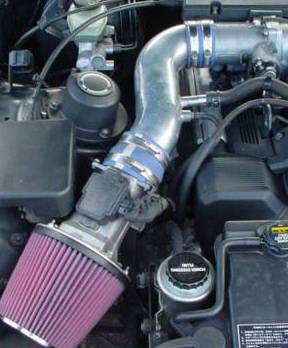 |
Here is the custom intake tested on the dyno day. It was sucking hot air,
but we compared it to a standard airbox and a new filter with the lid open which was also
sucking hot air. The cars went worse if anything. So the custom intake is good for:
but not for performance. And no pod filters as well as the standard filter. Even the good quality K&N isn't as good (I have read the Society of Automotive Engineers test on filtration, paper beat K&N for filtration) |
| So all up I would not recommend a custom intake if performance is your main goal on a naturally aspirated car. I think Yamaha had a hand in developing the intake system - a bunch of highly qualified engineers designed and built the intake and they got it right - so just leave it alone - you would be hard pressed to make anything better. Even the back of the airbox that connects into the Air Flow Meter is a beauty - a bellmouth and large gradual flow to the AFM will never be beat by any AFM adaptor for a pod. The only restiction in the stock system is the small hole in the front of the standard airbox (and the AFM itself - I have measured the pressure drop for all components). You can't change the AFM (yet.....) but if you don't mind a little bit of extra maintenance then removing the snorkel and modifying the airbox as in the BFI is the best way to go. | |
